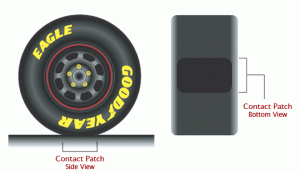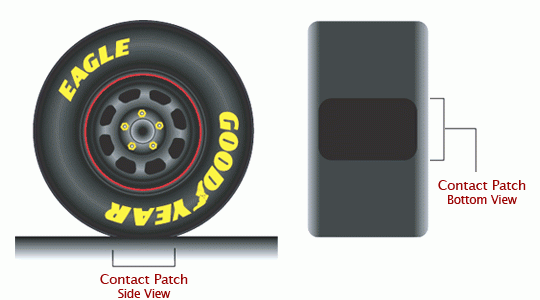 In my last blog I talked about frontal area, and how a small frontal area seems to be one of the key ingredients in making a gravity racer that can go really fast. Part of my reasoning for this was that the Bodrodz guys in the USA were the quickest out there, and this was surely to do with the incredibly small frontal area of their cars even though they used kart tyres, which must offer a lot of grip due to large contact patch, and the corresponding amount of rolling resistance (or at least I thought at the time). Fast Donnie was kind enough to leave a comment, and brought up the idea that grip has nothing to do with contact patch – only the material the tyre is made from, and the amount of weight placed on it.
In my last blog I talked about frontal area, and how a small frontal area seems to be one of the key ingredients in making a gravity racer that can go really fast. Part of my reasoning for this was that the Bodrodz guys in the USA were the quickest out there, and this was surely to do with the incredibly small frontal area of their cars even though they used kart tyres, which must offer a lot of grip due to large contact patch, and the corresponding amount of rolling resistance (or at least I thought at the time). Fast Donnie was kind enough to leave a comment, and brought up the idea that grip has nothing to do with contact patch – only the material the tyre is made from, and the amount of weight placed on it.
That’s interesting, I thought.
So I did some reading and what do you know – he was bang on right. Contrary to popular belief, a wider, fatter tyre does not offer more grip because of increased contact area, or for any other reason either. All that matters is the material that the wheel is made from, and the force that is applied to it, regardless of contact patch size.
As a follower of F1 I have been pleased to see the wider tyres in 2017, and the 3-5sec faster lap times associated with them. I, like many, assumed this was because of more grip offered by the wider contact patch on the fatter tyres. This, however, is incorrect.
If this all sounds unbelievable, there’s a little experiment that people have done that proves it. Take a brick. A brick has three different size faces – the large flat top and bottom face, the smaller side faces, and the much smaller end faces. Sit the brick on any surface and loop some string around it and tie a knot to make a loose “belt”. Into this, hook a spring type weighing scale and start to pull the brick sideways. You will be able to read off the weight on the scale when the brick starts to slide on the surface. Repeat this for all three faces. You’ll find that the amount of force (weight) required to make the brick slide in all three cases is the same, even though the contact patches are all different. This is because the materials (the brick itself and the surface on which it sits) and the weight of the brick remain the same.
Great, more in depth article HERE
So Why Are “Sport” Tyres Fatter?
Yes – sport tyres are often more grippy. This is simply because they are made from a softer rubber. As previously stated, the only thing that matters is the materials and the force applied. However, softer rubber wears out quicker, so tyres made from softer compounds are made bigger to “share the wear”. If a tyre was made that was twice as soft/grippy in the same size as a regular tyre it would only last half as long, so making them bigger helps to keep its durability in an acceptable range. The new F1 tyres for 2017 are simply softer.
The second reason is that of strength. Sports tyres have to cope with a lot of power – be it from acceleration, braking or cornering forces. This force basically attempts to rip the tyre from the rim, so having a meatier, stronger construction helps the tyre to keep its shape. Temperature is an issue too – extreme forces generate a lot of heat, and a larger tyre is more able to dissipate heat rather than melting and falling to bits.
How Does This Relate to Gravity Racing?
Well, first up, gravity racers don’t have an engine, so acceleration forces through the tyre are not an issue. Also because braking is often minimal (especially if you’re doing a high speed run) neither are braking forces. The only real area that you need grip for is cornering, and the amount of grip required for the corners on the track that you’re racing down depend on how fast you’ll be going and how much your car weighs. More speed and more weight will require more grip to corner without having to slow down first.
So really, as with many things in gravity racing, the optimal amount of grip required depends very much on your car, and the race it is being designed to take part in.
What’s Next?
Well, now I’m wondering if there is a direct correlation between grip and rolling resistance. Is there a “best” way to have just the amount of grip you need, with the minimal amount of rolling resistance, and this will be the subject of my next blog, after some more research… 🙂
Please comment below!



Another quick comment on grip that is important to remember. The contact patch’s limit gets divided up even in gravity racing. If your cornering and on the edge using 100% of the available grip and you start to apply brakes you are now reducing your cornering grip by whatever percentage you are using for braking. Your contact patch can only have 100% grip ( in any direction ) no more, Applying even the slightest amount of braking that slows the car requires grip for deceleration. That has to come from the 100% that the contact patch has to offer.
LikeLiked by 1 person
You should give CartieSim a try. It allows you to see the effect of changing weight, rolling resistance, grip, CdA etc. You’ll find that there is no single optimum design, since different courses require different combinations. See http://gravityracing.org.uk/cartiesim/download
LikeLiked by 1 person
This is a complicated issue. You’re right that Fast Donnie’s cartie has a very high top speed because of its low frontal area and good aerodynamics, which suits Les Eboulements very well. The course there is long enough for the added inertia and rolling resistance of the heavy and wide gokart wheels to be more than offset by the lower CdA. His acceleration is lower than it would be with lighter wheels, but it goes on for longer because of the low drag and hence reaches a higher top speed. Interestingly, if you use cartiesim to compare his speed profile on the hill to that of a cartie similar to Guy Martin’s (lower rolling resistance and inertia, but higher CdA), Guy’s cartie passes through the speed trap at a lower speed, but several seconds before Donnie’s. I.e. the quicker acceleration at the start gives a higher average speed for the whole run but a lower top speed.
So which would you want to be driving in a race? The one that goes through the finish line fastest or the one that got there first?
This exposes the fundamental issue when trying to find an optimum design. The “optimum” depends on what it is you are trying to optimise for and the course you are racing on. There is no single design that will do well everywhere.
LikeLiked by 1 person
I totally understand that – it’s a complex problem! I guess when i was designing my first build I realized I was presented with the question – what am I designing it for? The high speed run, although perhaps the most challenging brief, does also seem the simplest – few regs, a long smooth hill and top speed the only real aim. Having said that, with my budget being very low my new brief seems to be “make something fast that is very cheap” and thus the longboard wheels have become the main focus of my build. I know they have limitations, but as least I can learn about them and gain experience without it costing a lot of money. 🙂
LikeLike
I think these article is higly wrong, the contact patch AFFECT tyre grip, and yes, wider tyre have more grip, the author maybe don’t know the basic of how grip is generate, the basic coulomb law of friction dont’apply at viscoelastic materials like rubber so the experimet of brick is nonsense. tyre generate grip from histeresis,and a little also from adhesion. i can’t explain here all thyre mechanics so i reccomend to read the Michelin tyre grip guide, it’s more a book than a guide (>200 pages) and explain very well and in a simple way how tyre perform. is avaible online as pdf, it’s only a bit hidden
LikeLike